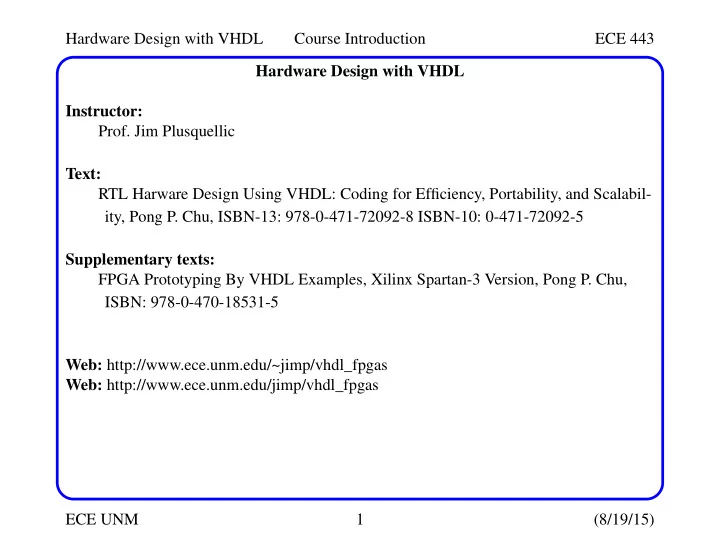

Hardware Design with VHDL Course Introduction ECE 443 Hardware Design with VHDL Instructor: Prof. Jim Plusquellic Text: RTL Harware Design Using VHDL: Coding for Efficiency, Portability, and Scalabil- ity, Pong P. Chu, ISBN-13: 978-0-471-72092-8 ISBN-10: 0-471-72092-5 Supplementary texts: FPGA Prototyping By VHDL Examples, Xilinx Spartan-3 Version, Pong P. Chu, ISBN: 978-0-470-18531-5 Web: http://www.ece.unm.edu/~jimp/vhdl_fpgas Web: http://www.ece.unm.edu/jimp/vhdl_fpgas ECE UNM 1 (8/19/15)
Hardware Design with VHDL Course Introduction ECE 443 Course Goals Simply stated, my objective is to teach you to: Take an algorithm and/or specification, either combinational, sequential, or an FSMD, write synthesizable VHDL code for it, and download & debug the code on an FPGA To accomplish this, you will learn: • A set of fundamental components of digital design • A set of synthesizable constructs in VHDL -- a hardware description language • Xilinx Vivado software development tools Platform Choices • Full-custom ASIC • Standard cell ASIC • Gate array ASIC • Complex field programmable logic device (FPGA), CPLD • Off-the-shelf ICs (Commercial off-the-shelf or COTS) ECE UNM 2 (8/19/15)
Hardware Design with VHDL Course Introduction ECE 443 Device Technologies Standard Cell: Circuit made of a set of pre-defined logic, known as standard cells, with basic logic gates, NAND, NOR, D FF, etc. Layout of a cell is pre-determined, but layout of the complete circuit is custom- ized Masks needed for all layers Gate Arrays: Circuit is built from an array of a single type of cell (known as base cell) Base cells are pre-arranged and placed in fixed positions, aligned as one- or two- dimensional array More sophisticated components (macro cells) can be constructed from base cells Masks needed only for metal layers (connection wires) ECE UNM 3 (8/19/15)
Hardware Design with VHDL Course Introduction ECE 443 Device Technologies FPGAs/CPLDs: Device consists of an array of generic logic cells and general interconnect struc- ture Logic cells and interconnect can be "programmed" by utilizing "semiconductor fuses or "switches", i.e., customization is done "in the field" Two categories: CPLD (Complex Programmable Logic Device) FPGA (Field Programmable Gate Array) No custom mask needed Comparison of Technologies Area (Size): silicon "real-estate" Standard cell is the smallest since the cells and interconnect are customized FPGA is the largest, overhead for "programmability", capacity cannot be completely utilized ECE UNM 4 (8/19/15)
Hardware Design with VHDL Course Introduction ECE 443 Device Technologies Comparison of Technologies (cont.) Cost NRE (Non-Recurrent Engineering) cost: one-time, per-design cost Part cost: per-unit cost Time-to-market "cost" loss of revenue • Standard cell: high NRE, small part cost but large lead time • FPGA: low NRE, large part cost but small lead time SUMMARY FPGAs Gate Array Standard Cell Tailored masks 0 3 to 5 15 or more Area best (smallest) Speed best (fastest) Power best (minimal) NRE cost best (smallest) Per part cost best (smallest) Development cost best (easiest) Time to market best (shortest) Per unit cost depends on volume ECE UNM 5 (8/19/15)
Hardware Design with VHDL Course Introduction ECE 443 System Representation View: different perspectives of a system • Behavioral view Describe functionalities and I/O behavior Treat the system as a black box • Structural view Describe the internal implementation (components and interconnections) Essentially a block diagram • Physical view Adds more info to structural view: component size, component locations, rout- ing of wires, e.g., layout of a printed circuit board Structure and physical view: Structural Physical ECE UNM 6 (8/19/15)
Hardware Design with VHDL Course Introduction ECE 443 Levels of Abstraction How does one manage complexity for a chip with 10 million transistors? Abstraction : simplified model of a system The model shows only the selected features and ignores detail The purpose of abstraction is to reduce the amount of data to a manageable level and to enable the focus to be on only the critical features . Levels of Abstraction Four levels • Transistor level • Gate level (schematic) • Register transfer level (RTL) (where we will work) • Processor level RTL: A design methodology in which the system operation is described by how the data is manipulated and moved among registers ECE UNM 7 (8/19/15)
Hardware Design with VHDL Course Introduction ECE 443 Development Tasks The main tasks associated with the development of a custom digital circuit: • Synthesis • Physical design • Verification • Testing Synthesis A refinement process that realizes a description with components from the lower abstraction level Type of synthesis: • High-level synthesis (Behavioral to RT-level description) • RT level synthesis (RTL behavioral to RT-level structural representation) • Gate level synthesis (RT-level structural to gate level) • Technology mapping (gate level to standard cells or CLBs in FPGAs) Physical Design Refines the structural view to a physical view and generates a layout ECE UNM 8 (8/19/15)
Hardware Design with VHDL Course Introduction ECE 443 Development Tasks Verification Check whether a design meets the specification and performance goals • Functionality • Performance (timing) Methods of Verification Simulation spot check: cannot verify the absence of errors Can be computation intensive Timing analysis Just check delay Formal verification Apply formal math techniques to determine properties E.g, equivalence checking Hardware emulation ECE UNM 9 (8/19/15)
Hardware Design with VHDL Course Introduction ECE 443 Development Tasks Testing Testing is the process of detecting physical defects in a die or a package that occurred at the time of manufacturing ECE UNM 10 (8/19/15)
Recommend
More recommend